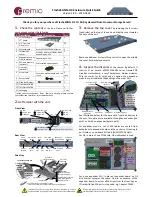
1. Turning on the Server
Express5800/T110f-S User’s Guide
110
Chapter 3 Setup
1.1
POST
Power-On Self-Test (POST) is a self-diagnostic program stored in the server as standard. POST
automatically runs immediately after the server is turned on and checks the motherboard, memory, processor
(CPU), keyboard, and mouse. POST also displays the start-up messages of different utilities during the
operation.
Usually, you do not need to check the message of POST.
Check messages displayed at POST in the
following cases:
•
When introducing a server
•
If you suspect a failure
•
When you hear beep many times during the time between the power on and OS startup
•
When any error message is displayed
1.1.1
POST sequence
Explains how POST runs in order.
Important
•
Do not press any keys or perform mouse operations while POST is in
progress.
•
Powering on the server, after you installed or removed an optional PCI
board or moved it to another slot, may display the message that indicates
incorrect board configuration and suspend POST.
In such a case, press
F1
to continue POST. Board configuration can be
made using the utility described later.
1. POST runs automatically when the server is turned on.
NEC logo appears on the screen as factory settings.
2. When
Password On Boot
is set to
Enabled
on the
Security
menu in the BIOS setup utility (SETUP),
the logo is displayed, and then the password entry is displayed. If you enter the wrong password three
times in a row, POST stops and you cannot proceed to the subsequent operation. In this case, turn off
and on the server.
Important Do not set a password until you install the OS.
3. If <Esc> key is pressed, the logo disappears and the details of POST are displayed.
Tips
To show the details of POST without pressing <ESC> key, set
Quiet Boot
to
Disabled
in the
Boot
menu of the BIOS settings.
4. POST displays several types of message. These messages let you know that the installed CPU or
connected keyboard and mouse are detected.
















































